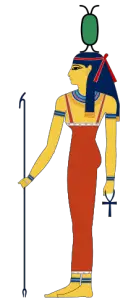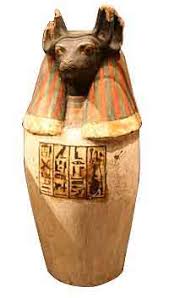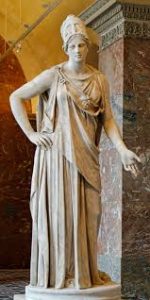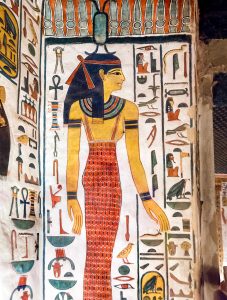Who is Neith in ancient Egypt?
Neith is one of the ancient deities of Egypt. She was a major goddess of the Lower Egypt region. She is the goddess of creation, motherhood, funeral & war. During the prehistoric & early-Dynastic period, she gained immense popularity. As the available sherds of evidence indicate that. She also kept her significant position as a deity even to the end of the Pharaonic period.

What is the meaning of ‘Neith’?
In ancient Egypt, the meaning of the name ‘Neith’ is the ‘divine mother’. Thus, this meaning signifies the importance of the goddess in the motherhood.
The goddess of Lower Egypt
Neith wears the Red Crown of Lower Egypt. It indicates her very close association with Lower Egypt. Thus, she is the most important deity of Lower Egypt. Her one title was ‘hose of the bee’. This also imdicates her association with Lower Egypt. Because bee became an important monarchical symbol. It was incorporated with the developed royal titulary often associated with Lower Egypt.

A creator goddess
Neith played an important role in the creation. The waters of goddess Nun started the creation. Neith is identified with that water. She is also associated with the creator deity Mehet-Weret. As a creator goddess, she is also known as the ‘great cow’ and the ‘great flood’. She is specifically called Neith ‘the eldest, mother of the gods, who illuminated the first face’.
A funerary goddess
Neith also played an important role as a funerary goddess. According to Pyramid Texts, she watched over the deceased Osiris along with Isis, Serket & Nephthys. These four deities watched over the four canopic guardians. Neith’ place is at the east side of the coffin. She is responsible for the protection Daumutef who is the guardian of the stomach of the deceased. According to ‘Book of that which is beyond’, She aids the king & Re himself n the underworld journey.

A warrior goddess
Neith is also an important warrior goddess. She had been associated with both hunting & warfare from the earlier time f her emergence. Thus, her epithets include ‘mistress of the bow’ & ‘ruler of arrow’. The ancient Greeks identified Neith with Athena. Because Athena was their war goddess.

A mother goddess
Neith was also worshipped as a mother goddess by ancient Egyptians. According to a text of 6th century BCE, She invented birth. During the Old Kingdom period, she was regarded as the mother of crocodiles. From the time period of the New Kingdom, she has been regarded as the mother of deities as well as humans.
The iconography of goddess Neith
In pre-Dynastic time, she was represented through a symbol. It was, two crossed arrows mounted on a pole. Later, it became her emblem. Her first anthropomorphic representation came from the Early Dynastic period. Here, she is in human form. She wears two bows on her head. But she did not wear the Red Crown of Lower Egypt at this earl representation.
In the later representations, specifically from the time period of the 5th Dynasty, she started wearing the Red Crown. She usually holds the ‘was‘ sceptre & the ‘ankh‘ symbol. As a warrior goddess, she holds a bow & arrow or a harpoon. In later times, she also came in zoomorphic form.

The cult of Neith
During the Early Dynastic period, she was one of the most important deities. In the later period, she was also widely venerated. Userkaf was a pharaoh of the 5th Dynasty. He re-emphasized on the veneration of this deity. Then, it was the Middle & the New Kingdom. She lost her status mostly. Later, the 26th Dynasty witnessed the rejuvenation of her status. During this time, Neith got a proper cult centre. It was the Delta city of Sais. This city belongs to the modern day Sa el-Hagar. The Gareco-Roman period also emphasized on her veneration. During this time, her great festival was celebrated on the thirteenth day of the third month of the summer season each year.